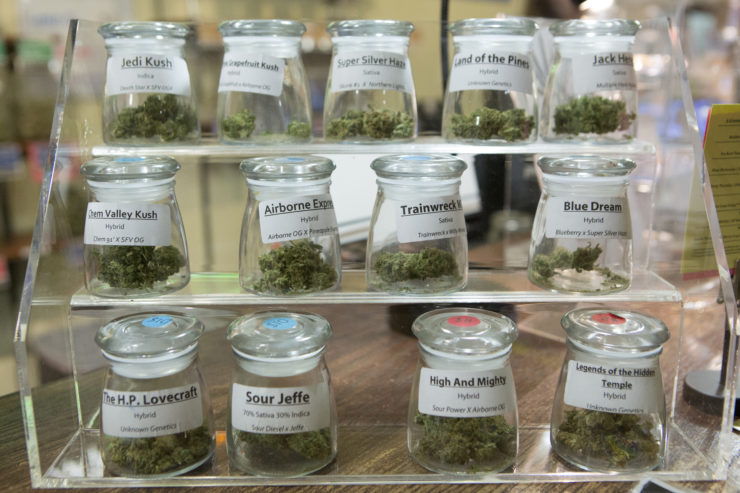
ResponsibleOhio, a pro-marijuana legalization group, gives out promotional materials to college students in 2015. Roughly 200 million Americans currently live in a state with some form of legalized cannabis
In early 2014, John Ingold, a longtime reporter for The Denver Post, noticed that the number of parents of young patients registered with the state to gain access to medical cannabis had grown from dozens to hundreds. They came from across the nation and the globe—Oklahoma, Minnesota, Pennsylvania, even Ireland. They sought an oil created from a high-less compound in cannabis, cannabidiol (CBD), which parents hoped would control their children’s seizures, which were resistant to other medicines.
What more than anything else propelled the influx of desperate parents into Colorado was “Weed,” a documentary by CNN chief medical correspondent Sanjay Gupta that aired in the summer of 2013 and was watched by an audience of 1.21 million. In it, Charlotte Figi, a then 6-year-old girl with a severe form of epilepsy called Dravet Syndrome, goes from having hundreds of seizures a week to only a couple of small episodes a month after she starts taking CBD.
While clinical trials related to CBD are currently under way in the U.S., there is no conclusive evidence that CBD is effective in Dravet Syndrome cases. In some cases, there might be a placebo effect. Indeed, Ingold reported on a study that found that families who migrated to Colorado were three times more likely to say cannabis helped their kids than those already living in the state.
Seeking not a story only of science but one of human longing for a medical miracle, Ingold, photographer Joe Amon, and videographer Lindsay Pierce collaborated on a feature about one family reflected in the soaring number of minors registered for medical cannabis. Ana Watson, a mother moving her family from North Carolina to Colorado to pursue treatment for her 12-year-old son, Preston, who also had Dravet Syndrome, agreed to give them access.
Over the course of nine months, a team of 12 at the Post came together to produce “Desperate Journey,” a three-part series that also included photos, videos, and illustrations to tell the Watson family’s story. The Pulitzer Prize Board in 2015 selected “Desperate Journey” as a finalist, saying the series was “an intimate and troubling portrayal of how Colorado’s relaxed marijuana laws have drawn hundreds of parents to the state to seek miracle cures for desperately ill children.”
There are a million [cannabis-related] stories, many of them complicated, that all cry out for sharp arm’s-length journalism
At a time when roughly 200 million Americans live in a state with some form of legalized cannabis, the need for in-depth reporting about the drug is urgent. Patients, doctors, researchers, regulators, recreational consumers, and industry members are arguing over whether to focus on the plant’s pharmaceutical potential or to treat cannabis like alcohol, all the while vigorously debating regulations that dictate how the plant is grown, tested, packaged, and sold. As a result of the discrepancy between the legal status of cannabis at the state and federal levels, and among states, reporters are left with little precedent and no central authority to turn to for data, sources, and research. Many journalists find themselves in new or unfamiliar roles, sometimes taking positions, sometimes becoming part of the story.
Cannabis also intersects with other issues, like criminal justice and business. Regardless of whether California votes in November to legalize cannabis use, the cannabis industry is already booming. Legal cannabis sales in Colorado, Oregon, Alaska, and Washington are on track to hit $2 billion this year. Cannabis tax dollars are a windfall for state and local governments, going toward things like school construction and cannabis research, substance abuse prevention, and education. In 2014, more than 600,000 Americans were arrested for cannabis possession, but that number is expected to drop as more states allow adults to consume cannabis.
“The country is in the midst of a major cultural, legal, and economic shift on cannabis,” says Mike Hoyt, former executive editor of the Columbia Journalism Review and current adjunct professor at the Columbia University Graduate School of Journalism. “What are the implications of this shift—for the economy, for the culture, for our health and safety? How should this stuff be regulated and what are the potential costs of poor or nonexistent regulation? Who is getting rich and who is getting jobs? There are a million stories, many of them complicated, that all cry out for sharp arm’s-length journalism.”
Our involvement in cannabis journalism started when we took off in a red Beetle in 2010 to report for our book, “A New Leaf: The End of Cannabis Prohibition” (The New Press, 2014). Wanting to continue documenting the story, we launched Cannabis Wire, a digital publication focused on the cannabis industry, last October with an innovation grant from the New York City Mayor’s Office on Media and Entertainment and a Magic Grant from the Brown Institute for Media Innovation, a collaboration between the Columbia University Graduate School of Journalism and the Stanford University School of Engineering. The Made in NY Media Center, a City of New York initiative to help Brooklyn-based startups, offered us office space, and training to transition from journalists to people who could drop an elevator pitch. We built out Cannabis Wire’s advisory board with some of the smartest minds in media, which includes Hoyt, Emily Bell of the Tow Center for Digital Journalism, and Barin Nahvi Rovzar of Hearst, among others.
Just five years ago, the bulk of cannabis coverage came from advocacy publications like High Times, the Village Voice Media Group’s Toke of the Town, SFGate’s Smell the Truth, or from cannabis beat reporters at alternative weeklies. When coverage did reach mainstream publications, there was a tendency toward bad puns, like “Rocky Mountain high” and “gone to pot” and plenty of stoner or ‘60s-era references.

A small but growing number of newsrooms are spending valuable resources to cover the essential cannabis issues around safety and efficacy, science and health, and the booming industry
Since 2013, though, local and national publications have invested in the cannabis beat and coverage is slowly maturing. The Denver Post created a digital publication called The Cannabist. The International Business Times hired a cannabis reporter, who has since been laid off. The Sun-Times Network, publisher of the Chicago Sun-Times, launched a cannabis vertical called Extract. Vice expanded its cannabis coverage with the TV series “Weediquette.” NowThis has NowThis Weed, BuzzFeed News hired a drugs reporter, and Mashable has a page devoted to stories from High Times.
But quality doesn’t always follow quantity. Not all journalists take or have the time to sort through the labyrinthine world of cannabis to tell fact from fiction. For example, when a company called Potbotics suggested its EEG brain scans could recommend cannabis strains to users, The Guardian gave the company press, including the company in a list under a header: “Looking to invest? Try these for size.” Popular Science took a different approach and questioned whether the product could work, quoting experts who suggested that the claims were unfounded.
Alison Holcomb, who authored Washington’s legalization initiative and led the campaign for it when she was head of drug policy for the American Civil Liberties Union of Washington, says she’s grateful for coverage as an advocate, but thinks that, in general, journalists tend to laser in on the same click-worthy issues, like how much money states are making, or who is getting rich. “There’s a titillation factor in most places where it’s new,” she says. “Unfortunately, I feel like a lot of that is pretty superficial and there aren’t enough reporters that are digging in.”
A small but growing number of newsrooms and journalists are spending valuable resources, in a time of layoffs and buyouts, to cover the less buzzy but essential cannabis issues around safety and efficacy, science and health, and the booming industry. The Oregonian published two investigations that prompted better cannabis quality control in its state after it found high levels of pesticides in cannabis products and edible potency mis-labeling. And New York Times columnist Maureen Dowd’s first-person account of a bad cannabis trip, while fodder for Internet hot-takes, changed the conversation around edibles regulations across the U.S. And The Denver Post’s “Desperate Journey” presented the difficult reality that hundreds of families might have uprooted their lives because of false hope.
Denver Post photographer Joe Amon turned to Facebook to find a family that he, Ingold and others on the team could follow. Intimacy and trust were necessary to get the story, but, over the course of nine months, this closeness also presented ethical dilemmas. Should Ingold advise the family he was reporting on, sharing his knowledge of the cannabis bureaucracy in Colorado to make their lives easier?
Throughout the story, Ana, Ingold’s subject, stumbled through the process of convincing a doctor to recommend cannabis as a treatment, finding the right strain and preparation of cannabis, a reliable supply, and learning how to administer the cannabis oil, which isn’t always easy. Ingold, after covering cannabis for the Post for years, knew all about the patchwork of state laws and the changing nature of rules within his state. But Ingold didn’t want to alter or become part of the story.
“It could be really difficult for somebody coming in from out of town to understand what the hell all of this means,” Ingold says. “You just kind of want to help. But you kind of need to stand back when you know something about how the law applies or how the law works. You need to be able to see them struggle because you’re trying to get an idea of what a family goes through when they come here. Not what a family with a reporter who can help them out goes through when they come here.”
Ingold said that as he watched Ana learn more about the legal bureaucracy over time, the desire to offer information lessened. He decided that it would be okay to step in if an action he took wouldn’t alter the natural course of the story. One day when Ana ran errands and left Preston with her mother, Milly, Preston had a big seizure and Milly couldn’t lift Preston on her own. Amon stepped in. “Joe picked him up and carried him to the couch and afterward said, ‘Oh, you know, I probably shouldn’t have done that.’ But sometimes you just got to be a person,” Ingold said.
“Desperate Journey” presented the difficult reality that hundreds of families might have uprooted their lives because of false hope
One piece of information Ingold did not have to hold back was that CBD might not work; Ana knew, but the chance that it could made it worth trying, not just for her, but for hundreds of other families. The piece ultimately juxtaposed Ana’s anecdotal-based hope and the skepticism of medical professionals. In one section, Ana wrote on Facebook, “Cannabis oil doing amazing things for Preston! Singing big green tractor and no am seizures!” In others, Ingold would quote researchers urging caution.
For his documentary, Gupta spent 18 months traveling the world to distill and make sense of the fragmented but potentially revolutionary cannabis research taking place. And it brought him to the conclusion that both he and the federal government were wrong to suggest that cannabis wasn’t medicine when, in fact, it could be.
The change of mind came for Gupta when he looked abroad. While more than a thousand cannabis studies have taken place in the U.S., he said, most look at harm potential. He argued in his documentary that it might have something to do with the fact that the research supply of cannabis, and much of the funding for such research, was overseen by the National Institute on Drug Abuse. But when he took an international view of the research, “I realized it was a different picture. I thought, there’s something new here, something that I didn’t really know, and I think maybe a lot of people who are viewers didn’t know either. And I thought it was worth reporting on,” Gupta said.
In addition to interviewing doctors about both the medical and abuse potential of cannabis, Gupta talked to a researcher who said federal officials were “stonewalling” research, and a federal official who said the criticism was unfair. He traveled to states like Colorado and also as far off as Israel, a place he called in the documentary the “medical marijuana research capital,” where THC was first discovered and CBD was first extensively studied, and where medical cannabis is legal at the national level. “I had been reporting on this issue for some time and had written articles saying that I was not impressed by the potential medicinal benefits. And yet, after looking at this data, I thought that not only did it seem to offer benefits, for some situations it was the only thing that offered benefits. So in part as a journalist, but also as a doctor, I thought it was an important message to get across,” Gupta said.
The one-hour documentary, “Weed: Dr. Sanjay Gupta Reports,” was the most comprehensive piece of primetime broadcast journalism ever produced about medical cannabis. And Gupta went on to produce two more one-hour documentaries on medical cannabis. The first two hour-long parts of the “Weed” series won a duPont Award (judges said he parsed “the science and politics of a divisive issue”).
New York Times columnist Maureen Dowd is another journalist with a national platform who influenced cannabis policy. She didn’t intend to write a story about herself when she flew to Colorado in January 2014 to cover the first legal recreational use of cannabis sales in the world. “For something that is such a profound social revolution that’s going to spread to the rest of the country very quickly, you have to cover it,” she said.
Dowd wrote two columns at the end of the month, but they left out perhaps the most important part of her visit. Dowd purchased a THC-infused caramel chocolate bar and took a couple of nibbles in her Denver hotel room. Later that night, she ended up curled into herself for eight long hours, certain she might be arrested—and certain she might die. She had way, way too much THC.
Excessive amounts of THC, the primary psychoactive component of cannabis, can result in agonizing paranoia. But exactly what is a standard dose, or how to convey comparisons to commonly known intoxicants like alcohol, is still being sorted in this brand new industry.
Initially, Dowd didn’t write about the incident because, she said, “I was trying to figure out: to what extent should I have known that edibles, which I’d never had before, were metabolized differently?” But then, a student visiting Denver jumped to his death from a balcony after eating a cookie that contained 65 milligrams of THC. The next month, a man ate a piece of cannabis candy with 100 milligrams of THC, along with some painkillers, and shot and killed his wife. State officials now recommended a first serving closer to 5 milligrams of THC.
Dowd called Andrew Freedman, Colorado’s director of marijuana coordination, to discuss her experience. He said her decision “to air her foolishness” was both “brave” and “beneficial.” “I felt like I had learned something really important and I wanted to share it,” Dowd said. “I wanted to warn people that the consumer tips that should be there and labeling and instructions were not yet there.”
Not everyone shared Freedman’s view of Dowd’s column, “Don’t Harsh Our Mellow, Dude,” in which she detailed her experience in Denver and highlighted efforts to improve packaging and labeling for dose-based cannabis edibles in the face of industry pushback. Still, Dowd’s column, and the online chatter, helped transform edibles regulation in Colorado at a time when edibles popularity and cannabis tourism were on the rise. Almost half of all cannabis sales involved edibles in 2014. And a Colorado Tourism Office survey of more than 2,000 individuals found in 2015 that 23 percent of those asked said legal cannabis factored into their decision to visit. Freedman said, “People started to understand more that you could actually have a pretty bad experience with marijuana, particularly marijuana edibles.” As of February 2015, in Colorado, each 10 milligram cannabis edibles serving must be wrapped individually or somehow sectioned.

Preston Watson, shown here with his grandfather, is the subject of The Denver Post's "Desperate Journey" series, which was a finalist for the 2015 Pulitzer Prize in Explanatory Reporting
There is still, however, no definitive answer to one issue that comes up in each and every state that legalizes cannabis: stoned driving. Denver-based Associated Press reporter Kristen Wyatt was unaware of the lack of data behind this core regulatory question when she was assigned a story on stoned driving in early 2012, months before Colorado’s vote to legalize cannabis. Wyatt’s piece, “New wrinkle in pot debate: stoned driving,” opens with a character who captured the debate that erupted around the issue: a medical cannabis patient in Colorado who said that the limit her state was considering would take away her right to drive because she’d always be above the threshold. So Wyatt set out to answer some questions: how high is too high to drive? And how dangerous is driving while high?
Wyatt thought she’d call some experts, read some research, and write the story. But it wasn’t that easy. Wyatt went to the obvious sources—the National Highway Traffic Safety Administration, the National Institute on Drug Abuse, some academic research databases—but found that “there was so little credible information that it was almost impossible.” Research so far suggests cannabis intoxication begins anywhere from 2 to 10 nanograms of THC per milliliter of blood; there simply isn’t a national agreed upon equivalent of the .08 percent BAC that defines drunk driving.
The story changed, and so did Wyatt’s role. She quickly found that she needed to take a “totally different approach” to how she reported and wrote the piece, which she said happens often on the cannabis beat. Instead of stating how high is too high to drive, Wyatt presented the research underway to address the unknowns, and spoke with people on all sides of the debate. She said that her job was made more difficult by advocates on both sides of the issue who misrepresented what little statistics or data there was to make their own case. “We are so used to, as journalists, going to the government and if the government says it, then that’s what it is,” Wyatt said. “It’s a really uncomfortable spot for a journalist to find yourself when the government doesn’t know something and you feel like, ‘I am not comfortable telling people when you’re too high to drive.’ And if the government doesn’t know, how the heck am I supposed to know?”
Journalists will soon have more data to inform their reporting. States like Colorado and Washington have begun to collect data specifically about cannabis-impaired drivers to determine if stoned driving is increasing, and a July report from the National Highway Traffic Safety Administration (NHTSA) found an increase in THC-positive drivers in Washington after legal sales began. The NHTSA is conducting its most comprehensive research yet to determine the exact effect of cannabis on drivers.
The Oregonian’s main cannabis reporter, Noelle Crombie, set out to understand the unregulated landscape of cannabis quality control in Oregon as the state crafted its own regulations for the medical and recreational use industries in 2014 and 2015. As a result of federal prohibition, there is no top down regulation on things like organic standards for cannabis, which would come from the U.S. Department of Agriculture, or guidelines for appropriate pesticides for cannabis, which would come from the Environmental Protection Agency States are, one by one, figuring it out. And this means that sometimes, reporters on the cannabis beat are connecting dots before their state governments.
The state did not yet oversee testing for cannabis potency and pesticides, and an unregulated cottage industry for testing was born. This meant that there was a potentially huge consumer story because there no central authority to verify for the nearly 70,000 patients, or the upcoming hundreds of thousands of consumers in the recreational market, whether cannabis products had unsafe levels of pesticides, or whether a product’s potency matched the label. It’s like a patient taking an Advil and not knowing whether it’s 50 milligrams or 500.
“The state really had no idea what was coming or going through labs, what standards labs were using. It was a really hands off system that’s really hard to make sense of without data,” Crombie said. Her solution? “We created our own data.” Crombie brought the idea of testing cannabis to her editors, who jumped at it.
No newsroom had done this sort of cannabis testing, and some editors were uneasy. This story presented a number of legal and ethical hurdles for the Oregonian. First, only medical cannabis patients could buy medical cannabis. Who from the newsroom could buy and handle the supply that would be tested? Even if they could procure it, many conventional agricultural labs weren’t testing cannabis, since it is still federally illegal. How could they get quality data?
As the industry changes and becomes more powerful, “Journalists are probably going to find themselves asking themselves different questions”
Editor Mark Katches, who was particularly enthusiastic, consulted Poynter ethicist Bob Steele, who had previously advised the newsroom. First, they decided, it would be okay if a staffer with a qualifying medical condition became a medical cannabis patient for the purpose of buying cannabis products to be tested. The newsroom could cover the costs of getting a medical cannabis recommendation, the cannabis products, and the testing. The newsroom needed to document the “chain of custody” around the cannabis and every step it went through during the testing process. They’d need to be transparent with readers about their methodology. And they would need to “bulletproof the findings,” Crombie said, by doing multiple tests.
Crombie convinced a scientist at a conventional agricultural lab (who expressed wanting nothing to do with cannabis) to test the same products after the first battery of tests from a lab that did test cannabis. She recommends that journalists who plan to test cannabis products do the same. “You can’t really argue with the science.”
Armed with data, Crombie wrote one piece entitled “Potency of edibles doesn’t match labels,” followed by another, “Pesticide-laced pot reaching patients.” Following the Oregonian’s investigation, published in March and June 2015, respectively, some companies consulted their lawyers, and at least one issued a recall. Some product manufacturers blamed the labs for inaccurate results, while others pointed fingers at the growers from which they sourced cannabis with pesticides. “Readers were alarmed. Consumers were alarmed. I think it added to the sense of urgency among regulators that they needed to tackle this issue,” Crombie said.
Other news organizations, including The Denver Post and The Globe and Mail, have since done their own testing of cannabis products. The first recall on cannabis products in Colorado happened after the Post’s own investigation, for which Crombie’s work was an inspiration. “The regulators don’t necessarily know the landscape as well as we would expect them to with a more mature industry. So journalists are identifying those issues and putting a spotlight on them,” Crombie said. “You’re explaining those issues not just to readers who are interested, but to the people who are responsible for regulating the industry.”
For his piece, “Reeferegulatory challenge,” included in the global edition with the cover piece, “The right way to do drugs,” The Economist’s Britain editor, Tom Wainwright sought to provide an international view of the different ways that countries were thinking about cannabis regulation, including issues like cannabis advertising restrictions, potency limits, rates of taxation and where the tax revenue would go. While most pieces about legalization tend to focus on one jurisdiction, Wainwright understood that a wide angle look at how jurisdictions influence each other would be incredibly useful to the reader.
Wainwright traveled to Denver, Colorado to get under the hood to understand how the state’s regulatory structure worked. He spoke with Uruguayan officials, the first country to follow U.S. states, to outline what they’d borrowed from states like Colorado, and what they would leave behind. By looking at these two very different places, he found, for example, that while Colorado has seen lobbying by the cannabis industry, marketing through discounts and loyalty programs, and increasingly sophisticated branding, especially by celebrities like Snoop Dogg, Uruguay intended to keep profit motive low, and was focused on curbing the black market and associated crime.
Wainwright realized early in his reporting that legal cannabis should be covered as a business story. After three years in Mexico reporting on the drug war and the illegal drug trade for his book “Narconomics,” during his time as The Economist’s correspondent there, he was used to covering the cannabis trade through that context. But he needed to change his mindset to get the story right. “If you just cover it like a war or a crime story then you end up getting a lot of stuff wrong,” he said. “I think the more you treat this as a business story, the more you open your eyes to the different aspects that you’re going to have to look at: the taxation, regulation, the safety standards.”
Now that cannabis is legal, he said, news organizations, including his own Economist, will have to continue to think about how to cover the beat. The Economist used to tend to have the same people who covered crime and terrorism cover cannabis; now it’s the responsibility of the journalists who cover retail, including alcohol and tobacco.
This is a question that an increasing number of newsrooms will face this fall, as cannabis legalization will be on a handful of ballots, including the nation’s most populous state, California. Wainwright predicts that as the industry changes and becomes more powerful, “Journalists are probably going to find themselves asking themselves different questions.”




